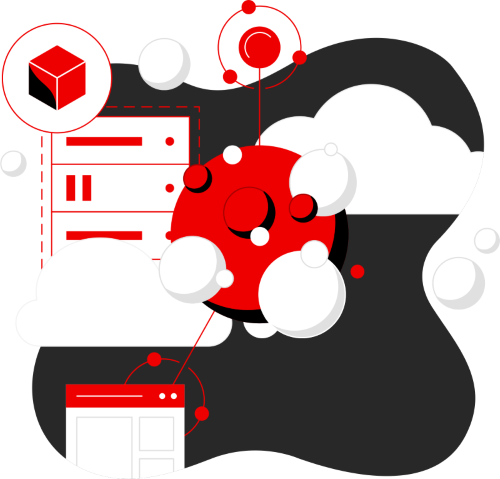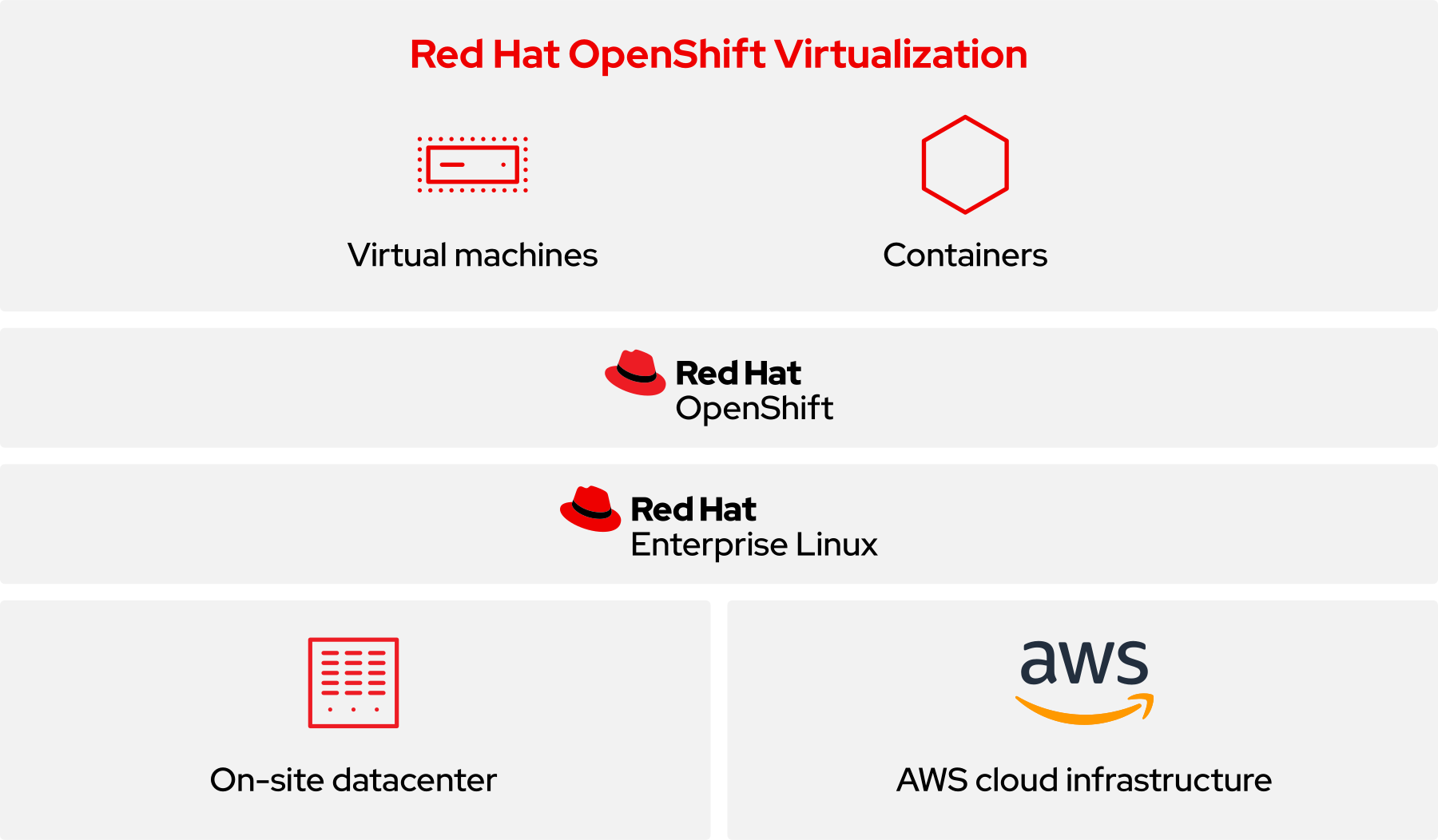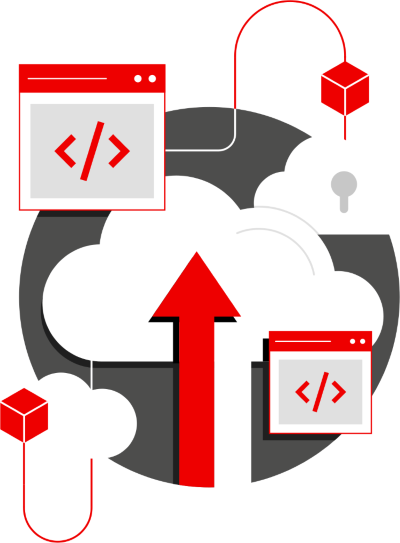15 reasons to migrate virtual machines to Red Hat OpenShift Service on AWS
Virtualization infrastructure continues to evolve
For more than 2 decades, organizations have relied on virtualization technologies to deliver innovative applications and services that streamline operations, optimize costs, and promote new business opportunities. The introduction of virtual machines into datacenters helped IT teams efficiently use resources, improve flexibility, and optimize infrastructure performance. As public cloud resources became more accessible, virtualization platforms evolved to make use of the scalability, agility, and potential cost benefits offered by new cloud computing models.
Now, many organizations are reassessing their virtualization platforms and strategies to ensure they have the right combination of consistency, efficiency, and support for their future operations and cloud-based applications. These organizations want to rapidly migrate to unified, cost-effective platforms that can handle their existing virtual machines while preparing them for IT modernization. Even so, many organizations will continue to use virtualization technologies for years to come to maximize their return on investment and schedule operational changes when it’s least disruptive to business.
Modern, cloud-native application platforms that support both traditional virtual machines and lightweight technologies like containers across hybrid and managed cloud environments are of particular interest for organizations that want to get ahead. Teams can readily migrate their current virtual machines to the new platform and run them alongside container-based applications to take advantage of new approaches to building and deploying applications.
At the same time, container orchestration platforms often include tools and automation that help IT teams streamline lifecycle management of their applications across massive hybrid cloud environments. IT teams can deploy and administer all workloads—virtualized or containerized—using common processes and tools while taking advantage of new innovation in monitoring, development and deployment pipelines, GitOps, service meshes, and serverless technologies. As a result, organizations can continue to run the virtualized workloads their business relies on while modernizing their applications and approaches at their own pace.
Migrate to a cloud-native platform for all workloads
To be successful, IT organizations need a cloud-ready application foundation that meets their current virtualization needs while preparing them for future modernization and change. Red Hat® OpenShift® provides a modern, enterprise-ready infrastructure platform for running virtual machines and container-based applications. Powered by containers, Kubernetes, and DevSecOps capabilities, Red Hat OpenShift is a foundation for rapidly building, deploying, running, and managing both existing and new applications at scale and with security across hybrid, multicloud, and edge environments.
Jointly engineered, operated, and supported by Red Hat and Amazon Web Services (AWS), Red Hat OpenShift Service on AWS (ROSA) gives you a fully managed, turnkey application platform. This cloud service combines Red Hat OpenShift, AWS infrastructure, and an expert site reliability engineering (SRE) team to deliver a reliable foundation for innovation.
OpenShift Service on AWS offers more than just access to a managed application platform. It provides a complete, full-stack environment with all necessary services and technologies, simple self-service capabilities, and expert 24x7 support with a 99.95% availability service level agreement (SLA). Our SRE teams use proven best practices and extensive experience to build, operate, automate, and maintain your OpenShift Service on AWS deployment.
As a first-party cloud service, you can access OpenShift Service on AWS on-demand from the AWS console and integrate other AWS cloud-native services like Amazon CloudWatch, AWS App Runner, Amazon Cognito, and others. You can choose hourly billing or reserved instances, receive a single invoice for Red Hat OpenShift and AWS deployments, and use your AWS committed spend and discount programs for OpenShift Service on AWS.
With OpenShift Service on AWS, you can reduce support costs and increase operational efficiency while freeing your IT teams to focus on innovation.
Migrate your virtual machines to a cloud-ready virtualization platform
Included as a feature of Red Hat OpenShift and based on the Kernel-based Virtual Machine (KVM) and KubeVirt open source projects, Red Hat OpenShift Virtualization lets you migrate your Linux® and Microsoft Windows virtual machines to a unified application platform, at your own pace. By moving virtual machines from other platforms and running them on Red Hat OpenShift, you can get the most from your existing virtualization investments while taking advantage of cloud-native architectures, streamlined operations and management, and new development approaches.
You can run OpenShift Virtualization on OpenShift Service on AWS in a self-managed manner. Red Hat and AWS SRE teams administer the underlying Red Hat OpenShift platform and AWS infrastructure as usual, while your internal teams manage OpenShift Virtualization and the virtual machines running on it. Of course, our experts are still available to answer questions and support your teams as they use OpenShift Virtualization.
Expert platform and cloud management
With OpenShift Service on AWS, Red Hat and AWS experts manage your entire software stack, including:
- Cluster creation.
- Cluster management.
- Monitoring and logging.
- Network configuration.
- Software and security updates.
- Platform support.
Migrating your virtual machines to OpenShift Service on AWS delivers value for your organization, regardless of where you are in your application modernization journey.
Gain benefits across your organization
Here are 15 reasons to migrate your traditional virtual machines to a unified foundation based on OpenShift Service on AWS.
1 Maintain stability and support on a modern virtualization platform.
Migrating workloads from traditional to modern virtualization platforms can be complicated. To ensure a smooth and efficient migration process, you need to carefully consider virtual machine compatibility, possible configuration changes, and potential performance optimizations. Additionally, differences in virtualization platform deployment and management processes and tools need to be accounted for in your migration plans, especially when moving between cloud providers. Preemptively validating virtual machine compatibility, using warm migration capabilities, and transitioning multiple virtual machines at once can help you move workloads between virtualization platforms rapidly and with less effort.
The migration toolkit for virtualization simplifies and speeds the process of moving existing virtual machines to OpenShift Virtualization, saving you time and minimizing potential errors. Plus, by combining this toolkit with Red Hat Ansible® Automation Platform, you can automate the migration of groups of virtual machines and related infrastructure—like networking and storage—at scale and speed.
2. Operate consistently and cost-effectively across hybrid and multicloud environments.
One of the key advantages of adopting hybrid and multicloud environments is flexibility. During application deployment, these environments let you choose between various datacenter and cloud resources to balance scalability, performance, and cost according to your business objectives. Application platforms that run and migrate virtual machine workloads consistently across hybrid and multicloud cloud environments help you simplify application deployment, optimize resource use, and maintain operational consistency.
OpenShift Virtualization supports self-managed physical servers in datacenters, edge environments, and public cloud environments, so you can deploy and manage your virtual machines on the optimal infrastructure. Because Red Hat OpenShift runs consistently in datacenter and public, private, and hybrid cloud environments, you can choose the right location for each application and virtual machine, and move them as needs change. This consistency also simplifies the migration of on-site workloads and virtual machines to AWS.
Additionally, OpenShift Service on AWS helps you achieve the right balance of flexibility and cost for your organization with your choice of purchasing options. Simplify procurement with unified billing and purchase management through AWS. Use and pay only for the instances you need with on-demand pricing. Or take advantage of discounted pricing over a longer period of time with 1- and 3-year reserved instance purchasing models. OpenShift Service on AWS also fully qualifies for 100% of your spend with the AWS Enterprise Discount Program (EDP).
3. Simplify IT operations with a unified platform.
Managing separate platforms for virtual machines and containers can lead to increased complexity, resource fragmentation, and operational overhead. Unified platforms that streamline infrastructure deployment, management, and monitoring across both virtual machines and containers can help you optimize resource use, eliminate duplicate efforts, and quickly adapt to diverse workloads.
OpenShift Virtualization simplifies operations with a single platform for virtual machines, containers, and bare-metal and serverless workloads. Standardize infrastructure deployment and maintain all workloads using a common, consistent set of established, enterprise tools. You can also streamline Day 2 operations from provisioning to compliance to deprovisioning with Ansible Automation Platform.
Plus, you can continue to use your existing infrastructure with OpenShift Service on AWS via certified partner integrations. Deploy and manage your preferred applications more easily and confidently with certified operators and Helm charts that encompass detailed vendor expertise. For example, AWS offers a variety of operators for managing AWS services from within Red Hat OpenShift.
4. Modernize your applications over time, on your schedule.
While migrating monolithic or n-tier applications on virtual machines to containerized, microservices-based workloads can enhance scalability, improve productivity, and increase agility, it can also require significant investments in time and resources. Combining platforms that support mixed applications—those incorporating a combination of virtual machines, containers, and bare-metal and serverless workloads—with modern application development processes and tools can help you strategically transform your applications on your schedule and according to your unique needs.
With OpenShift Virtualization, you get all of the application modernization features and benefits of OpenShift Service on AWS. Integrated tools and capabilities help you build, modernize, and deploy applications that include both virtual machine- and container-based workloads.
With OpenShift Service on AWS, you can build an ideal software foundation for all application transformation use cases using a complete, integrated portfolio of products and cloud services that work together reliably. Directly access and integrate other AWS cloud-native services for compute, database, analytics, machine learning, networking, mobile, and more, including:
- AWS Cloud Financial Management: Cloud cost management and optimization solutions
- AWS Cloud Databases: A set of fully managed, purpose-built databases, including Amazon RDS
- AWS Machine Learning services: A comprehensive set of AI and ML services, infrastructure, and resources
- AWS Management and Governance: A set of business management and governance control services, including Amazon CloudWatch
- AWS Networking and Content Delivery: A broad set of services—like Amazon CloudFront—for running workloads and delivering content over a reliable, security-focused network
- AWS Security, Identity, and Compliance: A broad set of identity and access management, threat detection, compliance, and network, application, and data protection services, including AWS Identity and Access Management, AWS Key Management Service, and AWS Secrets Manager
- AWS Cloud Storage: A portfolio of solutions—like Amazon S3 and Amazon Elastic File System—for storing, accessing, protecting, and analyzing your data
- Amazon Elastic Container Registry: A fully managed container registry with high-performance hosting
5. Provide self-service options for deploying virtual machines.
Manually deploying virtual machines is an inefficient, error-prone process that can result in inconsistent configurations, long deployment times, and an increased risk of security vulnerabilities. Self-service capabilities let users rapidly and reliably deploy preapproved, security-compliant virtual machine configurations, when they need them and without opening an IT service ticket.
With OpenShift Service on AWS, users can quickly, easily, and independently provision the resources they need without manual intervention from IT operations teams. Automated resource delivery lets staff members start working on their schedule. Following standard Red Hat OpenShift role-based access controls (RBAC), users can create virtual machines in their projects—and then grant access to other project members—to help their entire team quickly get the resources they need. Virtual machine instance types simplify self-service provisioning via predefined operating system images, workload types, and hardware requirements. You can also use templates to deploy virtual machines that require advanced configuration, including virtual appliances.
Transform your applications
Red Hat OpenShift runs consistently across on-site datacenters, cloud environments, and managed cloud services, so you can choose the optimal environment for your applications and virtual machines.
6. Integrate virtual machines into your development and deployment pipelines.
Using virtual machines in development and deployment pipelines can increase the scalability, consistency, and speed of your application delivery processes. Integrating virtual machines in development pipelines lets you deploy standardized, isolated, and reproducible environments for coding, testing, and debugging to increase consistency across development teams. Using virtual machines in continuous integration/continuous deployment (CI/CD) pipelines provides clean, isolated environments for each stage—from build and test to release and deployment—for controlled, reliable application delivery.
With OpenShift Virtualization, you can create, manage, and run commands in virtual machines within development and CI/CD pipelines based on Red Hat OpenShift Pipelines to streamline infrastructure and application delivery. OpenShift Service on AWS also gives you access to a large library of integrated, certified tools, development environments, and self-service capabilities that let developers code at speed.
7. Take advantage of production-ready virtualization hypervisor technologies.
Hypervisor performance, stability, and security are critical for efficient, dependable virtualization infrastructures. Adopting extensively tested and validated hypervisors that are supported by trusted vendors can help you better manage virtualized workloads at scale and increase reliability across diverse environments.
As the underlying hypervisor for OpenShift Virtualization and Red Hat Enterprise Linux, KVM is a security-focused, high-performance, open source hypervisor. First released in 2007, KVM provides a stable, efficient virtualization foundation for organizations worldwide. Today, Linux virtualization powers critical IT infrastructure for a large number of global financial services firms, airlines, manufacturers, public sector organizations, and telecommunications companies and is a popular choice for public cloud deployments.
8. Boost virtual machine performance.
Speedy recovery times are critical when IT services become unavailable due to hardware failures, power outages, or other issues that result in downtime. When this occurs, the applications running in the virtual machines that were using those services are also unavailable. An application platform that can recover and reboot virtual machines quickly and efficiency is essential for keeping your business up and running at all times.
OpenShift Virtualization exhibits near linear boot times for large numbers of virtual machines, so your critical applications can always be available. And with OpenShift Service on AWS, you can deploy virtual machines on a variety of Amazon EC2 instances to optimize performance. Automatic resource provisioning and retirement let you rapidly adapt to changing demand without impacting virtual machine or service availability or performance.
9. Accommodate multiple guest operating systems.
In virtualized environments, support for guest operating systems increases the diversity of workloads, applications, and services you can run on shared physical infrastructure. Compatibility with a wide range of operating systems, advanced security features that isolate guests and hosts, and support from experts with extensive experience simplifies virtualization across varied IT environments.
Red Hat tests, certifies, and supports guest operating systems for use with OpenShift Virtualization—including certification for Microsoft Windows guest support through Microsoft’s Server Virtualization Validation Program (SVVP)—to help you create an IT environment that meets your business needs. You can also continue to use common in-guest tools like PowerShell, Ansible, and Puppet with virtual machines running on OpenShift Virtualization.
10. Decrease risk with advanced security features and best practices.
Security vulnerabilities in virtualized environments with shared hardware infrastructure increase the risk of unauthorized access, data breaches, and potential service disruptions. Strong isolation technologies, consistent security policies, and adherence to least privilege principles enhance the overall security of virtual machine workloads.
OpenShift Virtualization follows the restricted Kubernetes pod security standards profile and runs virtual machine workloads without root privileges, helping you comply with current, industry-standard security practices and protect your organization. Red Hat OpenShift also includes core security features—like access controls, network security, and an enterprise registry with a built-in scanner—to protect your platform from the start. OpenShift Service on AWS is certified to and managed in compliance with key security standards, including Payment Card Industry Data Security Standard (PCI DSS), System and Organization Controls (SOC) 2, and International Organization for Standardization (ISO) 27001.
In fact, AWS infrastructure includes many security features and more than 50 compliance certifications and accreditations help you protect your organization and assets. You can integrate other security and access management services—like Red Hat Advanced Cluster Security for Kubernetes, AWS Management and Governance, and AWS Security, Identity, and Compliance—to further safeguard your business and IT assets.
Read the OpenShift Virtualization reference architecture to learn more about performance and tuning.
11. Simplify live migration of virtual machines.
Live migration—moving a running virtual machine to another host without interrupting the workload—is crucial for maintaining continuous operations as infrastructure demands change. A virtualization platform that lets you configure, initiate and monitor live migrations across your environment helps balance workloads and avoid downtime during maintenance activities.
OpenShift Virtualization supports complete live migration workflows with a unified management console, configurable policies, virtual machine metrics, and traffic encryption to help you keep your applications running reliably. You can migrate live virtual machines between compute instances, storage instances, and even AWS Availability Zones.
12. Back up and restore virtual machines.
When unexpected events or system disruptions occur, backup and restore capabilities can help you recover virtual machines in less time and ensure continued operations. Creating frequent backups—representations of the state and data of a virtual machine at a specific point in time—provides the information needed to restore existing virtual machines.
OpenShift Virtualization lets you back up virtual machines automatically on demand or on fixed schedules, manage saved images, and restore workloads quickly to minimize the impact of disruptions on your business. Red Hat’s certified partner ecosystem also includes many third-party products for data storage, backup, and restoration. Using the Red Hat OpenShift Operator Framework, you can interact with many of these products directly from Red Hat OpenShift. For example, you can install and configure Ansible Automation Platform via an operator, and use the platform to automate virtual machine lifecycle management, including backup and restore operations.
13. Scale infrastructure as workloads change.
The dynamic workloads, diverse technologies, and rapid pace of development and deployment associated with modern applications places high demands on IT infrastructure. To ensure optimal performance and resource use, virtualization platforms must dynamically and efficiently scale up and down as workloads change.
Machine management features in OpenShift Virtualization—including autoscaling based on workload policies and machine health checks—help you administer infrastructure with greater flexibility and efficiency to meet modern application demands. And with OpenShift Service on AWS, our SRE team monitors your clusters 24x7 and will notify you if a cluster needs to be scaled to avoid an outage.
14. Support a collaborative, open source model.
Open source development models promote collaboration, innovation, and community-driven development to rapidly deliver new, advanced virtualization technologies. With access to stable community innovation, open standards for broad compatibility, and open application programming interfaces (APIs) for flexible integration, open source technologies can help you build efficient virtualized environments across datacenter and cloud infrastructures.
OpenShift Virtualization uses container-native virtualization technology to deliver ongoing innovation. This technology is developed and maintained in KubeVirt, a Cloud Native Computing Foundation (CNCF) project. As the foundation of Red Hat OpenShift Virtualization, KubeVirt provides a unified development platform where developers can build, modify, and deploy applications residing in both containers and virtual machines in a common, shared environment.
15. Work with our cloud and virtualization experts.
Successfully planning, deploying, and maintaining a virtualized environment requires specialized skills and knowledge. Expert support and guidance, backed by extensive virtualization experience and in-depth platform knowledge, can help you optimally configure your environment, proactively resolve potential issues, and maximize performance, security, and reliability.
OpenShift Service on AWS helps you optimize support costs and operations with included, expert 24x7 support. Our SRE team automates the deployment and management of your clusters so your staff can focus on application development and strategic initiatives. Reduce costly downtime and maintain reliability and security with managed upgrades, patching, and threat monitoring and remediation. Resolve issues in less time via a single path to support through Red Hat or AWS. Access Kubernetes experience without retraining or moving existing staff or hiring new members. Although your teams are responsible for managing OpenShift Virtualization on top of OpenShift Service on AWS, our SRE and support staff are still available to answer questions and provide expertise about migrating, running, and managing virtual machines on the platform.
You can also speed deployment with migration planning assistance through Red Hat Consulting engagements or the AWS Migration Acceleration Program (MAP).
Deploy a consistent foundation for innovation
By giving you a single scalable and flexible platform for virtual machines and containers, OpenShift Virtualization reduces operational overhead and opens a straightforward path to modernization. This integration offers a unified approach for managing virtual machines and containers in an efficient, security-focused manner. And with OpenShift Service on AWS, you can take advantage of a unified foundation, integrated products and services, a large partner ecosystem, and expert support and services to transform your applications with less effort.
You can also apply modern application development principles to your virtual machines and run all of your applications and workloads consistently across on-site datacenter, edge, and cloud environments. Increase developer productivity, simplify operations, and streamline infrastructure and application delivery to better support your business. With OpenShift Virtualization and OpenShift Service on AWS, you can meet today’s business needs while preparing for future modernization and change.
See customer success with OpenShift Virtualization in action: sahibinden.com
To maintain its market-leading position against competition from start-ups and global retailers, Turkish classified listing and e-commerce platform sahibinden.com decided to modernize its IT infrastructure and work approaches.
The company began a 3-phase project to migrate its existing virtual machines into container workflows with Red Hat OpenShift, running in a private cloud environment across its 2 datacenters. As part of its shift to containers, sahibinden.com adopted an active-active datacenter configuration, where both datacenters share workload within the private cloud environment. New and refactored container-based applications are deployed across multiple Red Hat OpenShift nodes.
With this new architecture and DevOps workflows, sahibinden.com has decreased system reliability incidents by 97%, improved developer productivity and time to market, and enhanced its reputation for technology innovation.
Decreased system reliability incidents by 97%
Improved DevOps experience with unified management
Optimized container adoption with expert support and guidance
Red Hat OpenShift is the clear leader in enterprise Kubernetes. And while the virtualization market leaders can run Kubernetes on their virtualized infrastructure, only Red Hat OpenShift can run our whole virtualization environment within its Kubernetes container platform.
Ready to migrate your virtual machines?
Unify and streamline IT operations with a single, cloud-ready application platform for virtual machines and containers.
OpenShift Virtualization and OpenShift Service on AWS reduce operational complexity and provide a unified, modern, cloud-native infrastructure for all of your virtualized and containerized applications and workloads. Plan your path to modernization with a platform and cloud service that bring modern application development principles to existing virtual machines and prepare your organization for a cloud-native future.
Learn more about OpenShift Virtualization.
Learn more about OpenShift Service on AWS.
Get started with our self-paced online learning path for OpenShift Service on AWS.
Experience OpenShift Virtualization first hand, at no cost
The Red Hat Level Up Program gives eligible customers fully supported access to Red Hat OpenShift, including OpenShift Virtualization, for their team, department, or organization initiatives at no-cost for 1 year. Level Up OpenShift gives organizations a path to a cloud-native future, while letting them keep existing workloads running in virtual machines on a single platform.





